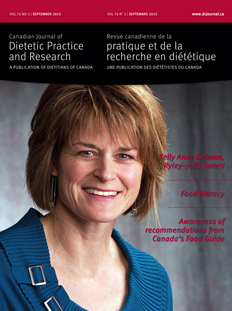Abstract
Purpose: School-based interventions may increase children's preferences for vegetables and fruit (V&F). This Canadian study measured changes in Indigenous First Nations schoolchildren's V&F knowledge, preferences, and home consumption following the implementation of a gardening and V&F snack program.
Methods: At baseline, 7 months, and 18 months, children in grades 1–6 (i) listed at least 5 V&F they knew, (ii) tasted and indicated their preferences towards 9 vegetables and 8 fruit using a 6-point Likert scale, and (iii) indicated their home consumption of 17 V&F.
Results: At all 3 time points, 56.8% (n = 66/116) of children provided data. Children listed a greater number of V&F at 18 months (4.9 ± 0.1) than at baseline (4.5 ± 1.0) or 7 months (4.7 ± .07) (F(1.6,105.6) = 6.225, P < 0.05). Vegetable preferences became more positive between baseline (37.9 ± 9.3) and 7 months (39.9 ± 9.2), but returned to baseline levels at 18 months (37.3 ± 8.7) (F(1.6,105.8) = 4.581, P < 0.05). Fruit preferences at 18 months (42.7 ± 3.0) were greater than at baseline (41.1 ± 4.3) and at 7 months (41.9 ± 5.1) (F(1.7,113.3) = 3.409, P < 0.05). No change in V&F consumption occurred at home.
Conclusions: Despite improvements in V&F knowledge and preferences, home consumption of V&F did not occur. Complementing school-based programs with home-based components may be needed to influence V&F intake of children.
Résumé
Objectif. Les interventions en milieu scolaire pourraient augmenter l'appréciation des légumes et fruits (L et F) chez les enfants. Cette étude canadienne a mesuré les changements quant aux connaissances relatives aux L et F d'écoliers indigènes des Premières nations, leurs préférences et leur consommation de légumes et fruits à la maison après la mise en œuvre d'un programme de jardinage et de collations à base de L et F.
Méthodes. Au début de l'étude, à 7 mois et à 18 mois, des enfants de la 1re à la 6e année ont : (i) dressé la liste d'au moins 5 L et F qu'ils connaissaient; (ii) goûté à 9 légumes et 8 fruits et indiqué leurs préférences sur une échelle de Likert à 6 points et; (iii) indiqué leur consommation à la maison de 17 L et F.
Résultats. À chacun des 3 points dans le temps, 56,8% (n = 66/116) des enfants ont fourni des données. Les enfants ont énuméré un plus grand nombre de L et F à 18 mois (4,9 ± 0,1) qu'au début de l'étude (4,5 ± 1,0) ou à 7 mois (4,7 ± 0,07) (F(1,6;105,6) = 6,225; p < 0,05). L'appréciation des légumes a augmenté entre le début de l'étude (37,9 ± 9,3) et 7 mois (39,9 ± 9,2), pour ensuite revenir aux valeurs initiales à 18 mois (37,3 ± 8,7) (F(1,6;105,8) = 4,581; p < 0,05). L'appréciation des fruits à 18 mois (42,7 ± 3,0) était plus marquée qu'au début de l'étude (41,1 ± 4,3) et qu'à 7 mois (41,9 ± 5,1) (F(1,7;113,3) = 3,409; p < 0,05). Aucun changement n'est survenu quant à la consommation de L et F à la maison.
Conclusions. En dépit des améliorations en lien avec les connaissances et l'appréciation des L et F, la consommation de L et F à la maison ne s'est pas produite. Il pourrait être nécessaire de compléter les programmes en milieu scolaire avec certains éléments à la maison pour influencer la consommation de L et F des enfants.



